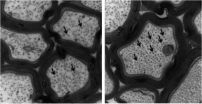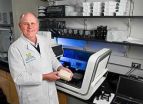Can naturally raised beef find its place in the industry?
2010-10-19
(Press-News.org) URBANA – As consumer demand for naturally raised beef continues to increase, researchers at the University of Illinois have discovered that naturally raised beef can be produced effectively for this niche market as long as a substantial premium is offered to cover additional production and transportation costs.
Naturally raised beef is produced without hormones or antibiotics, whereas traditional systems take advantage of technologies the industry offers such as ionophores like Rumensin® to improve feed efficiency and implants to improve gain and efficiency.
"Producers are asking many questions about the value of natural programs and the premiums needed to remain profitable," said Dan Faulkner, U of I professor of animal sciences. "Our goal was to find out the costs involved in natural systems focused on producing environmentally friendly, locally raised beef."
Researchers studied the effects of finishing management (confinement versus pasture) and production system (traditional versus naturally raised) on performance, carcass and economic characteristics in a group of early weaned Angus x Simmental steer calves at the Dixon Springs Agricultural Center in Simpson, Ill. The calves were fed on fescue pastures or confinement feedlots.
The study revealed that naturally raised steers can be produced effectively in either confinement or with a pasture finishing system, but they require a substantial premium of $110 with today's feed prices to justify the costs and returns.
Faulkner said that pasture finishing is $35 more profitable than confinement feeding using current feed prices, making it an attractive option for producers interested in raising locker beef for local markets with either natural or traditional production systems.
"I think this information will benefit smaller operations that would like to pursue a naturally raised market in a pasture finishing system, but may not be able to use a traditional confinement system," Faulkner said.
In addition, naturally raised beef in either pasture or confinement settings resulted in beef with higher quality grades.
"There continues to be more interest in naturally raised beef because organic beef standards are so high," Faulkner added. "We need to increase consumer education efforts because naturally raised beef is actually what many consumers are looking for these days."
Both organic and naturally raised steers do not receive hormones or antibiotics. The major difference between naturally raised beef and organic beef is that organic beef comes from cattle that are raised on organic pastures that have not been treated with chemicals or chemical fertilizers. In addition, these cattle can only be fed organic certified feeds.
Faulkner also differentiated pasture-fed beef from grass-fed beef.
"Grass-fed cattle cannot be fed any concentrate – they can only receive roughage," Faulkner said. "And that roughage must meet strict guidelines set by the USDA. On the other hand, pasture-fed cattle have access to a finishing diet and pasture."
Pasture-fed cattle have carcass and meat characteristics that are the same as traditionally finished cattle, he added. The meat characteristics of grass-fed cattle are quite different than the average consumer is used to eating.
Faulkner said naturally raised beef, regardless of finishing management, is a niche market that has great potential if consumers will pay premium prices.
"As producers, we need to be responsive to consumer demand," he said. "Currently, naturally raised beef is a very small percentage of the market. But it is a market that is growing at several hundred percent a year, and has been identified as a niche that consumers are very interested in."
INFORMATION:
This research, "Confinement vs. Pasture and Traditional vs. Naturally Raised Finishing Influences Performance, Carcass, and Economic Characteristics of Early-Weaned Steers," was published in The Professional Animal Scientist. Researchers include Faulkner, Dan Shike and Frank Ireland, all of the U of I.
ELSE PRESS RELEASES FROM THIS DATE:
2010-10-19
RIVERSIDE, Calif. – A popular view among geophysicists is that large amounts of water are carried from the oceans to the deep mantle in "subduction zones," which are boundaries where the Earth's crustal plates converge, with one plate riding over the other.
But now geophysicists led by the University of California, Riverside's Harry Green, a distinguished professor of geology and geophysics, present results that contradict this view. They compare seismic and experimental evidence to argue that subducting slabs do not carry water deeper than about 400 kilometers.
"The ...
2010-10-19
Much of medicine is based on what is considered the strongest possible evidence: The placebo-controlled trial. A paper published in the October 19 issue of Annals of Internal Medicine – entitled "What's In Placebos: Who Knows?" calls into question this foundation upon which much of medicine rests, by showing that there is no standard behind the standard – no standard for the placebo.
The thinking behind relying on placebo-controlled trials is this: to be sure a treatment itself is effective, one needs to compare people whose only difference is whether or not they are ...
2010-10-19
WHAT:
Scientists supported by the National Institutes of Health (NIH) have determined the complete genetic blueprints for 13 different strains of Borrelia burgdorferi, the bacteria that cause Lyme disease. The achievement should lead to a better understanding of how genetic variations among strains may result in different courses of illness in people with Lyme disease, the most common tickborne disease in North America. The wealth of new genetic data will also help scientists develop improved ways to diagnose, treat and prevent Lyme disease.
The first genome of a strain ...
2010-10-19
RIVERSIDE, Calif. (www.ucr.edu) – Researchers at the UC Riverside Bourns College of Engineering have built and successfully tested an amplifier made from graphene that could lead to more efficient circuits in electronic chips, such as those used in Bluetooth headsets and toll collection devices in cars.
Graphene, a single-atom thick carbon crystal, was first isolated in 2004 by Andre Geim and Konstantin Novoselov, who won the Nobel Prize in physics this month for that work. Graphene has many extraordinary properties, including superior electrical and heat conductivity, ...
2010-10-19
Cold Spring Harbor, NY -- A team co-led by neuroscientists at Cold Spring Harbor Laboratory (CSHL) has shed light -- literally -- on circuitry underlying the olfactory system in mammals, giving us a new view of how that system may pull off some of its most amazing feats.
It has long been known from behavioral experiments that rodents, for instance, can tell the difference between two quite similar odors in a single sniff. But in such instances, what precisely happens in the "wiring" leading from sensory neurons in the nose to specialized cells in the olfactory bulb ...
2010-10-19
When the storm winds blow, wind turbines have to show what they can stand up to. The wind blows hard against mills with the force of tons as the tips of the blades plow through the air at more than 200 kilometers per hour. But natural forces not only tear at wind turbines; machine components made of plastic or airplane wings must with stand substantial loads as well.
These days, we normally use sensors to measure whether these components are strained beyond capacity, and it requires a lot of effort to install them into the component parts or glue them onto their surface. ...
2010-10-19
ANN ARBOR, Mich. — Pediatric health care work force planning efforts are increasingly incorporating the roles of nurse practitioners and physician assistants, especially in plans to alleviate the perceived shortage of pediatric subspecialists.
However, results from four new studies of pediatric nurse practitioners, family nurse practitioners, neonatal nurse practitioners, and pediatric physician assistants published online today in the journal Pediatrics do not seem to support that idea. The work was conducted by the University of Michigan's Child Health Evaluation and ...
2010-10-19
PHILADELPHIA – Finding a drug that can cross the blood-brain barrier is the bane of drug development for Alzheimer's disease and other neurological disorders of the brain. A new Penn study, published this week in the Journal of Neuroscience, has found and tested in an animal model of Alzheimer's disease a class of drug that is able to enter the brain, where it stabilizes degenerating neurons and improves memory and learning.
In the normal brain, the protein tau plays an important role in stabilizing structures called microtubules in nerve cells, which serve as tracks ...
2010-10-19
OAK RIDGE, Tenn., Oct. 18, 2010 -- Theoretical work done at the Department of Energy's Oak Ridge National Laboratory has provided a key to understanding an unexpected magnetism between two dissimilar materials.
The results, published in Nature Communications, have special significance for the design of future electronic devices for computations and telecommunications, according to co-author Satoshi Okamoto of ORNL's Materials Science and Technology Division. The work was performed at Universidad Complutense de Madrid, synchrotron radiation facilities in France and Japan, ...
2010-10-19
ANN ARBOR, Mich. — Scientists at the University of Michigan Heath System and their collaborators have found four new DNA "hotspots" that may one day help guide new treatments for psoriasis, one of the most common autoimmune diseases in the country.
Using cutting-edge methods to peer into the hidden genetic underpinnings of the disabling and disfiguring disease, the research, published in Nature Genetics, further maps the as-yet unknown territories of psoriasis and psoriatic arthritis.
The findings could lead to new drug targets and tailored treatments for the skin ...
LAST 30 PRESS RELEASES:
[Press-News.org] Can naturally raised beef find its place in the industry?



